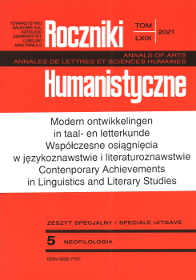“Language Corruption” Revised
Abstract
This contribution focuses on the question of whether languages can become corrupted. In general, linguists take the view that there is no such thing as “language corruption”; in their opinion, languages only change. Laymen, on the other hand, are not convinced by the linguistic arguments. In this paper, the stand is taken that it is not surprising at all that laymen are not willing to accept the view taken by linguists, since linguists and laymen focus on two different issues. Linguists are primarily concerned with the linguistic development as such (and the rise of the new form), whereas laymen focus on the actual acceptability of the new form. In addition, of further importance to the resistance that many changes meet with is the fact that present-day Dutch is heavily influenced by its substandard varieties, i.e. those varieties which, in the eyes of many speakers, have little or no prestige.
References
Audring, Jenny. Reinventing Pronoun Gender. LOT (Dissertatie Vrije Universiteit Amsterdam), 2009.
Dik, Simon C., en Jan G. Kooij. Beginselen van de algemene taalwetenschap. Het Spectrum, 1970.
Guido Geerts et al. Algemene Nederlandse Spraakkunst. Wolters-Noordhoff, 1984.
Haeringen, Coenraad Bernardus van. “‘Tangconstructies’ en reacties daarop”. (1947) Herdrukt in: Coenraad Bernardus van Haeringen, Neerlandica. ’s-Gravenhage, Daamen, 1962, pp. 260-268.
Haeseryn, Walter, et al. Algemene Nederlandse Spraakkunst. Nijhoff, 1997, 2e druk.
Hake, J.A. vor der. “Is de beleefdheidsvorm U ’n verbastering van UEd.?”. De Nieuwe Taalgids, 5, 1911, pp. 16-24.
Hermkens, H.M. Verzorgd Nederlands. Malmberg, 1966.
Karsten, G. “Hem en hun als onderwerp.” De Nieuwe Taalgids, 33, 1939, pp. 369-372.
Kloeke, G.G. Gezag en norm bij het gebruik van verzorgd Nederlands. Meulenhoff, 1951.
Kloeke, G.G. Een oud sjibboleth: de gewestelijke uitspraak van “heeft”. KNAW. (Verhandelingen, Afd. Letterk., N.R., LXIII, No. 1), 1956.
Koefoed, Geert. Benoemen. Een beschouwing over de faculté du langage. P.J. Meertens-Instituut (Dissertatie Universiteit Utrecht), 1993.
Marle, Jaap van. ‘One man, one voice’: iets over de democratisering van het Algemeen Nederlands. Open Universiteit (Afscheidsrede Open Universiteit), 2015.
Rooij, J. de. “Over hun en hen, en hen.” Taal en Tongval, 42, 1990, pp. 107-147.
Saussure, Ferdinand de. Cours de linguistique générale. (1916) (Édition critique préparée par Tullio de Mauro). Payot, 1976.
Schultink, Henk. Het Nederlands in 2002. Universiteit Utrecht. (Grijze Wijzen 2002, deel 3)
Stroop, Jan. Die taal, die weet wat. Athenaeum, 2014 (a).
Stroop, Jan. “Wat kan botst vaak met wat mag”. Interview Kennislink, 10/10/2014 (b).
Stroop, Jan. “De leraar Nederlands en z’n spagaat.” Gepubliceerd in: Neerlandistiek, Online tijdschrift voor taal- en letterkundig onderzoek, 2016.
Stroop, Jan. “Taalverloedering bestaat niet.” Interview in Noordhollands Dagblad, 21/03/2017.
Toorn, Maarten. C. van den. “Nieuwnederlands (circa 1920-nu)”. M.C. van den Toorn e. a., Geschiedenis van de Nederlandse taal. Amsterdam University Press, 1997, pp. 479-562.
Vooys, C.G.N. de. Nederlandse Spraakkunst. 5e druk, bewerkt door M. Schönfeld. Wolters, 1960.
Vries, Woobe de. Dysmelie: opmerkingen over syntaxis. Groningen, Gymnasium, 1910.
Copyright (c) 2021 Roczniki Humanistyczne

This work is licensed under a Creative Commons Attribution-NonCommercial-NoDerivatives 4.0 International License.





